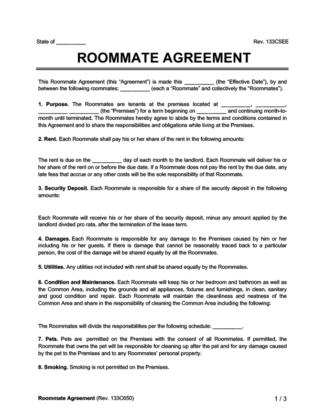
Use our Roommate Agreement to specify the rent and responsibilities of people who live together.

Updated May 25, 2024
Written by Jana Freer | Reviewed by Susan Chai, Esq.
A Roommate Agreement is a crucial contract between tenants living in the same home. It outlines shared expenses and house rules and serves as a guide to maintaining a harmonious living environment.
If roommates want to move out and sublet their rooms, they can talk to other housemates about using a sublease agreement for a new roommate.
A roommate agreement is a legally binding document that roommates can use to enforce financial obligations (like if another roommate doesn’t pay rent).
But, it is less likely that roommates can legally enforce the other aspects of the agreement (such as chores).
Try approaching a roommate situation by going the extra mile to make sure everything is clear, and remember—house rules can be as strict or flexible as you want them to be.
While a roommate agreement is a legally binding document, it is important to note that enforcing it in court can be challenging. This is because it often involves personal relationships and living arrangements, which courts may consider private matters.
If your roommate does not pay rent or utilities, you could file a suit and take them to small claims court. It is less likely to prove you’ve suffered clear damages from loud music, leaving dirty dishes in the sink, or not respecting quiet hours.
Every roommate agreement needs a breakdown of each tenant’s contribution toward shared expenses, including rent, security deposit, utilities, and shared supplies/groceries.
Indicate which parts of the house are common areas and which rooms are private to one or more tenants.
Roommates should unanimously decide what situations having guests over needs prior approval from other roommates. Set limits on how frequently roommates can have visitors and set guidelines for parties and larger groups of guests.
If your lease allows, consider whether you are okay with having a pet, even if none of your housemates currently have plans to get one.
Specify in writing what will happen if the pet owner is out of town or the pet causes any damage to the property.
Roommates should all contribute to regular maintenance and deep cleaning for shared areas like the kitchen, bathroom, and living space. We recommend creating a rotating schedule for daily, weekly, and monthly chores.
Communicating each tenant’s schedule is good so roommates can respect each other’s rest or study routines.
Designate quiet hours (for example, between 12 AM and 7 AM) where roommates agree to make little noise.
One of the biggest concerns of sharing a lease with roommates is what will happen if a roommate moves out before the lease ends.
Generally, if roommates move out early, they are still required to pay their portion of the rent. However, some leases allow tenants to sublet their rooms or find someone to take over their spot on the lease.
Include any guidelines for early move-out in your roommate agreement so tenants know what options they have if their situation requires them to move out early.
If you anticipate the possibility of an early move-out, it’s advisable to include specific guidelines in an Add/Remove a Tenant Lease Amendment.
To prevent one of the most common disagreements among roommates, ensure everyone is on the same page about if/when it is acceptable to borrow another tenant’s belongings.
Also, consider how these rules apply to shared items like cooking supplies.
It is impossible to prepare for every situation. Still, you might want to consider potential argument-starters like the ideal house temperature, shared parking space, or shower times.
If necessary, write down any extra stipulations after all roommates agree.
You may encounter disagreements over situations not covered in your roommate agreement, so be prepared to add to the house rules in the future.
Roommate agreements prevent disagreements among housemates, whether renters move in with strangers or close friends.
Many universities require students on campus to fill out a dorm roommate agreement. Having a set of roommate rules on paper can go a long way in preventing disputes and keeping roommate relationships amicable.
Creating a written agreement may feel unnecessary if you move in with friends. However, conflicts often arise because each person has unspoken expectations for how the roommates should do things.
Establish your preferences for a roommate, including their lifestyle, habits, cleanliness, and financial stability. Consider factors such as smoking, pets, guests, and quiet hours.
Reach out to friends, family, and colleagues to see if they know anyone looking for a roommate or can recommend someone trustworthy.
Use websites and apps specifically designed for finding roommates, such as Craigslist, Facebook Groups, Roomies, Spareroom, Roomster, or RoomieMatch. Create a detailed listing that highlights your preferences and the property’s features.
Once you have potential roommates, schedule interviews to get to know them better. Ask questions about their lifestyle, work schedule, financial stability, and other relevant factors. As soon as you receive requests, you’ll want to start with an income verification since it takes time.
When conducting interviews with potential roommates, you must ask questions that will give you a comprehensive understanding of their lifestyle and compatibility with your own. Start by asking about their daily routine, including work or school schedules, typical wake-up and bedtimes, and how they spend their free time.
This information will help you determine if your lifestyles will mesh well together. Remember, the interview process is about gathering information and assessing your comfort level and potential compatibility with the person.
Consider running a background check on potential roommates to ensure they have no criminal history or past evictions. Several websites offer background screening services for potential roommates, including credit checks, criminal history, and eviction data from all 50 states:
Ask for references from previous landlords or roommates to better understand their living habits and reliability. It’s crucial to ask about their past living experiences, such as whether they’ve had issues with previous roommates or landlords and how they handled conflicts.
Before making a final decision, meet the potential roommate to ensure you are comfortable with them and can communicate effectively.
Once you’ve found a compatible roommate, discuss your expectations for living together, including rent payments, chores, guests, and other house rules.
Draft a roommate agreement that outlines all the agreed-upon terms, including rent, utilities, and house rules.
Do not rush through, especially if there is an issue your roommates disagree on. It is better to pause and return to the agreement later than to hastily set a rule that not all roommates are happy about.
After finding a suitable roommate and agreeing to the terms, sign the lease agreement with the landlord. Ensure all roommates sign the contract before allowing them to move into the premises.
At the top of your roommate agreement, write down the state in which you are contracting.



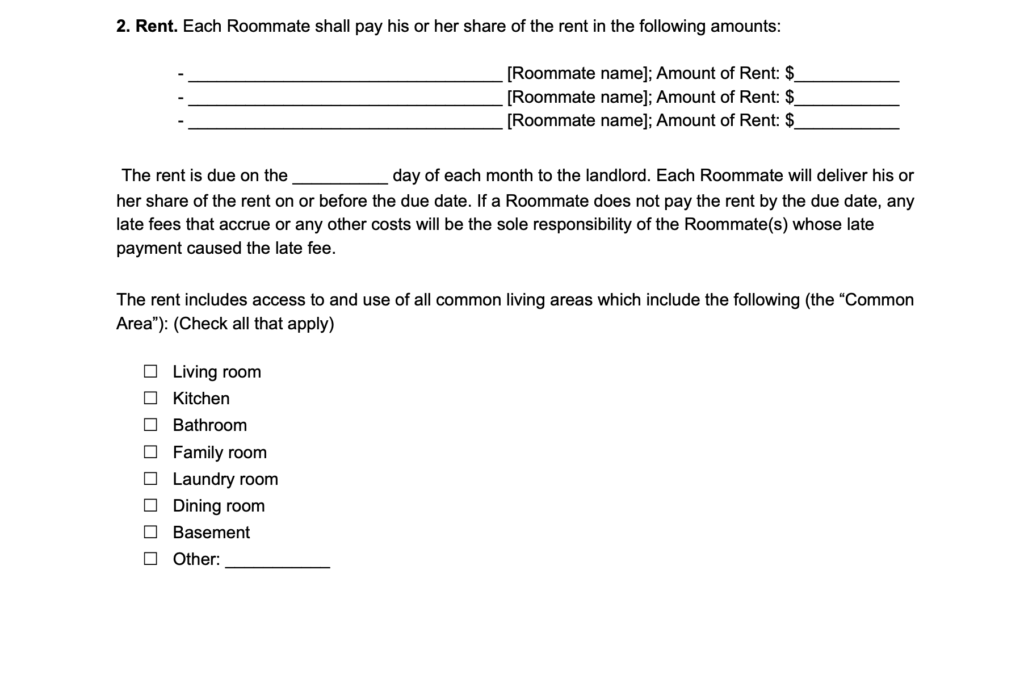
Roommate Name and Security Deposit Amount – provide the full name of each roommate and the amount of security deposit the roommate is responsible for.

Choose the utilities that the roommates will equally share. You can write any other utilities not on the list. Also, you may include additional details regarding the payment division (e.g., Jane Smith will solely be responsible for electricity).
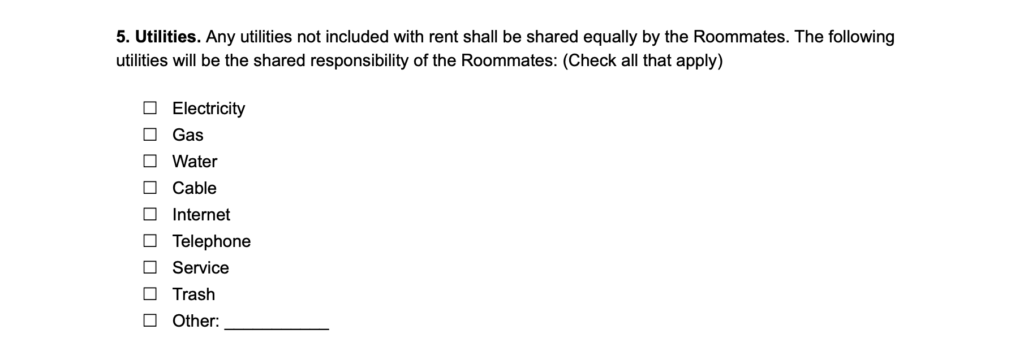
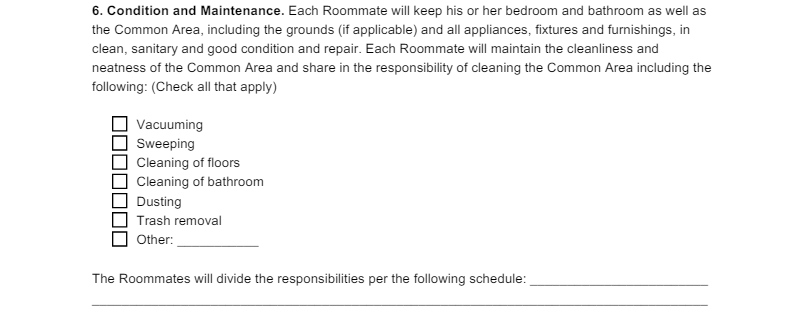
Specify whether or not the roommates may have pets on the property.

Choose whether or not smoking is prohibited on the premises or allowed with the consent of other roommates.

State whether or not roommates may consume and store alcohol on the property.

Choose whether or not roommates may possess firearms on the property.

Check this box if roommates agree not to borrow personal property from any other roommate without approval.


Note whether or not you want to include quiet hours. If yes, provide the start and end times and the days of the week.
Specify whether or not you want to restrict each roommate to one overnight guest at a time unless all other roommates agree. Also, you can choose the maximum number of nights a guest may stay per week without permission from all other roommates.
Specify the number of guests allowed at a party before a roommate needs approval from the other roommates.


State whether or not you want to include a provision on dispute resolution. If yes, the roommates agree to resolve disputes through mediation first.

Fill in the state’s laws that will govern the construction of the roommate agreement.

You can write any additional provisions here (e.g., use of storage or parking space).
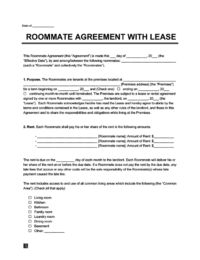
Use this roommate agreement when housemates will be signing the original lease.
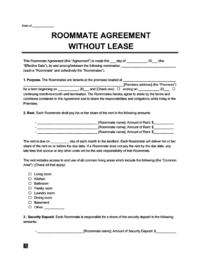
Use this roommate agreement when housemates will not be signing the original lease.

Create Your Roommate Agreement in Minutes!
(855) 335-9779, Monday-Friday, 9AM - 10PM EST
Copyright 2024 Legal Templates LLC. Legal Templates LLC is not a lawyer, or a law firm and does not engage in the practice of law. Legal Templates cannot and does not provide legal advice or legal representation. All information, software and services provided on the site are for informational purposes and self-help only and are not intended to be a substitute for a lawyer or professional legal advice. Use of this site is subject to our Terms of Use. Legaltemplates.net is owned and operated by Resume Technologies Limited, London with offices in London United Kingdom.
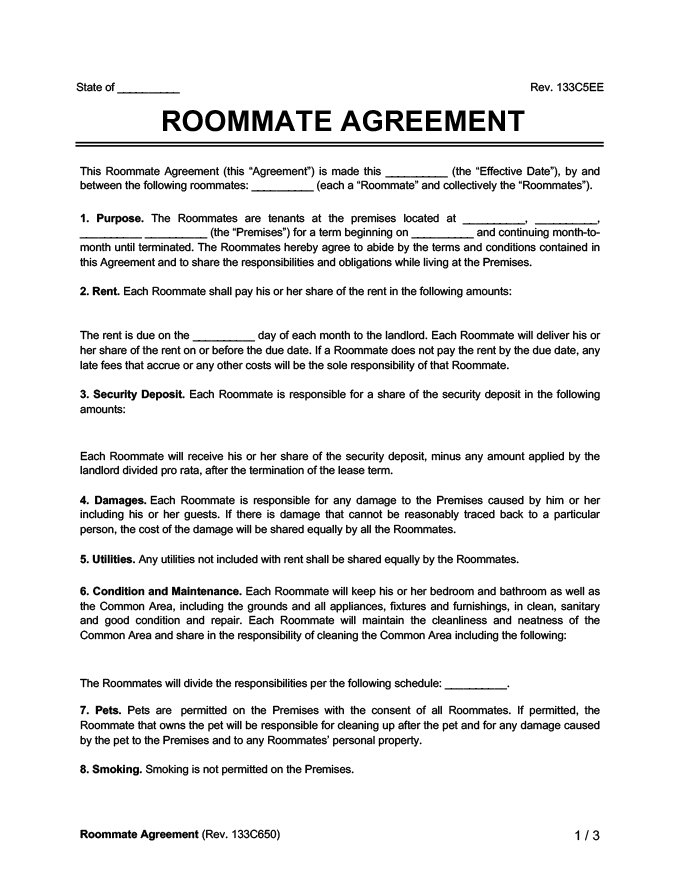
The document above is a sample. Please note that the language you see here may change depending on your answers to the document questionnaire.